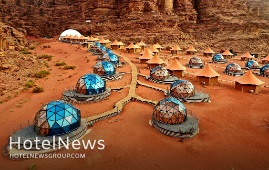
Hotels that we look forward to their exciting opening in 2022 Part 3; Nobu Santorini Hotel- Greece 🇬🇷 The 26th branch of Nobu Hotel in Greece will be opened in Santorini Nubo hotel architect Designed in the traditional whitewashed Cycladic style with minimalistic décor to optimally enhance the dramatic vistas beyond. Nobu Hotel Santorini offers 25 stunning accommodations, all with breathtaking views of the Caldera and the Aegean Sea. It offer a nobu restaurant, luxe spa, fitness center, two level infinity pool and five pool villas Nobu hotel opening this spring is also just 20 minutes from santorini international airport. It also offers a unique blend of Japanese hospitality and stunning Santorini and Whether you’re looking for Nobu Hotel classics or locally packages, explore our offers to find the stay that suits you best.
Create: Oct 22, 2022 Edit: Oct 22, 2022 TV
Hotels that we look forward to their exciting opening in 2022 Part 2 Ritz-Carlton Hotel in NewYork🇺🇸 Ritz-Carlton hotel in Manhattan’s was newly-built from the ground up with 250 guest rooms and 16 luxury penthouse residences. It will feature two new restaurants and a rooftop bar Guest Room Features & Amenities Daily housekeeping service and evening turndown service High-speed wireless Internet access Large flat-screen televisions Same 24 hour laundry services Online Keyless entry via Marriott Bonvoy App Guests can also chill out in the hotel’s signature Ritz-Carlton Spa and Fitness Center. the spa facilities include steam room, sauna, and private lounges to help you escape the hustle and bustle of the city. Visit the modern sensibility of some of the greatest art museums in the world just blocks away
Create: Oct 22, 2022 Edit: Oct 22, 2022 TV
Hotels that we look forward to their exciting opening in 2022 Part 1 CONRAD TULUM RIVIERA MAYA Hotel in Mexico🇲🇽 The hotel is the newest luxury addition to the Hiltons hotels portfolio CONRAD is known for its contemporary style the modern design sets the brand apart from waldorf astoria hotels and symmetry is key element at this particular property hotel. Rooms are arranged in several buildings along the shore line and at the topmost floor, the view of the sea is spectacular The hotel boasts five different restaurant. The main pool bar is the centerpiece of the hotel and in the evening the guests can enjoy drinks while listening to live music or dj performances Guests have multiple options of getting around the hotel they can order a golf car, take a bike or walk along the jungle paths The gym located in the basement of the hotel, yoga and spinning classes are offered throughout the week
Create: Oct 22, 2022 Edit: Oct 22, 2022 TV
Memories Aicha Luxury Camp is luxury desert camp in Wadi Rum Is an ideal base for your Arabian Desert adventure and stay , with spectacular mountains in the distance. The camp is sprawled across 4 kilo meters square and with 40 luxurious tent await those who seek the ultimate desert adventure. You can explore Wadi Rum in several ways: Jeep tours and Camel rides are a popular activity Combining modern style living and comfort while still living the authentic desert experience, Panoramic Luxury Suite offer the guests that will allow you to gaze at the magnificent moon and stars from your own comfortable bed. Aicha Restaurant With the total area of 700 square meters is ideal for receptions, group and other occasions. An unforgettable ambiance and experience for anyone looking for something special.
Create: Oct 22, 2022 Edit: Oct 22, 2022 TV
Today announced that it has completed an initial closing of the previously announced portfolio acquisition through its existing joint venture with GIC from affiliates of NewcrestImage. The initial closing included 26 of the 27 hotels totaling 3,533 guestrooms, two parking structures, and various financial incentives. The remaining hotel to be acquired is the currently under construction 176-guestroom Canopy by Hilton New Orleans which is nearing completion, and the joint venture expects to close on the acquisition of the hotel during the first quarter 2022 (collectively with the initial closing referred to as the “Transaction”). The total consideration for the Transaction is comprised of $776.5 million, or $209,000 per key, for the 27-hotel portfolio, $24.8 million for the two parking structures, and $20.7 million for the various financial incentives. The Transaction is expected to be immediately accretive to adjusted FFO per share, generate a stabilized net operating income yield of 8.0% to 8.5% including future capital investment and excluding any ancillary joint venture fees earned by Summit, and be leverage neutral to the Company’s balance sheet while preserving existing liquidity of nearly $450 million.
Create: Jan 15, 2022 Edit: Jan 15, 2022 International News
Over 94,000 domestic tourists have stayed in the province during the mentioned time, Jalil Jabari said on Thursday. In nine months, over 16,000 foreign travelers stayed in the province’s accommodation centers and it is estimated that 5,500 foreign tourists will stay in these units in the fourth quarter of the year, the official added. The accommodation centers have generated over 40 job opportunities during the mentioned time as well, he noted. Back in December, Jamshid Hamzehzadeh the head of the Iranian Hoteliers Association announced that following the planned measures, the occupancy rate of the country’s hotels, which had fallen below five percent because of the outbreak of the coronavirus, has reached 45 percent over the past three months. Multiple problems, notably the pandemic, caused a severe impact on the tourism industry, the official explained. Even before the coronavirus outbreak and in 2019, travel was reduced due to heavy rains and flooding across the country, and the hotel industry had to recoup nearly 100 percent of the costs paid for canceled hotel reservations, he added. The Iranian hoteliers have lost 220 trillion rials (about $740 million) over the past two years, he noted. However, some problems have been resolved and the hotels’ condition has improved, he mentioned. Back in October, the official announced that Iranian hotels are ready to receive foreign tourists as the issuance of tourist visas and the flow of foreign tourists from land and air borders would be resumed. Ninety percent of the hotel staff have been vaccinated against the coronavirus, so the hotels are ready to welcome foreign tourists, observing strict health protocols, he said. The main destinations of foreign tourists in Iran are specifically cities such as Mashhad, Qom, Tabriz, Shiraz, Yazd, and Isfahan, and to return to the figure of over eight million incoming tourists before the outbreak of the coronavirus, serious planning is required, the official added. Iraqi tourists will flood the country once the borders open, but attracting tourists from Europe will require some time, he noted. However, he noted that two-thirds of the hotel staff have lost their jobs, he added. Back in September, Hamzehzadeh announced that all employees of accommodation centers across Iran are scheduled to be vaccinated against the coronavirus. “To vaccinate staffs of all accommodation centers, including eco-lodges, apartment hotels, and guest houses, as well as hotels, more coordination with the Ministry of Health is needed,” he added.
Create: Jan 15, 2022 Edit: Jan 15, 2022 Regional News
The Iranian tourism industry has suffered $233m losses due to COVID restrictions over the past two years. “Iranian tourism facilities have incurred a loss of 69 trillion rials ($233 million) due to the outbreak of the coronavirus over the past two years,” an official with the tourism ministry has said. It has been a major shock to the tourism industry when the coronavirus emerged in 2019, Rokna quoted Mohammad-Kazem Kholdi-Nasab as saying on Monday. Citing an example, the official said, nearly all pre-scheduled trips were canceled during the new Iranian year holidays in March 2020 except for those that were necessary. “Travel is not believed to be the cause of the outbreak, rather it is a lack of adherence to health protocols that have caused the outbreak, but people canceled their trips anyway, causing major damage to the tourist facilities across the country,” he explained. With only two months until the upcoming new Iranian year holidays, the tourism ministry is preparing safe and smart travel packages for Iranian holidaymakers and travelers, he noted. Nearly 70 percent of the population has been vaccinated, so these trips may be able to partially compensate for the damage done to tourism facilities over the past two years, he mentioned. Last year the tourism ministry announced that the tourism of the country was growing before the corona outbreak, its revenues reached $11.7 billion in 2019, which accounted for 2.8% of GDP, nearing the average share of tourism in the world GDP, which was 3.2 percent. Iran was ranked as the second fastest-growing country in tourism based on data compiled by the World Tourism Organization. Experts expect Iran to achieve a tourism boom after coronavirus contained, believing its impact would be temporary and short-lived for a country that ranked the third fastest-growing tourism destination in 2019. The Islamic Republic expects to reap a bonanza from its numerous tourist spots such as bazaars, museums, mosques, bridges, bathhouses, madrasas, mausoleums, churches, towers, and mansions, of which 26 are inscribed on the UNESCO World Heritage list. Under the 2025 Tourism Vision Plan, Iran aims to increase the number of tourist arrivals from 4.8 million in 2014 to 20 million in 2025.
Create: Jan 8, 2022 Edit: Jan 8, 2022 Regional News
Alphabet’s self-driving car company Waymo is partnering with Chinese automaker Geely to create a fleet of all-electric, self-driving robotaxis. The cars will be designed in Sweden (where Geely owns Swedish carmaker Volvo) and will be adapted from Geely’s all-electric five-door Zeekr. Waymo will then outfit the cars with the hardware and software necessary for autonomous driving. Waymo said in a blog post that it plans to deploy the vehicles in the US as part of its existing fleet of self-driving robotaxis some time “in the years to come.” Concept images of finished vehicle shared by Waymo show a car that is designed specifically for autonomous ride-hailing trips. It has a flat floor, low step-in height, and B-pillarless design for easy entry and exit, as well as sliding doors, reclining seats, and plenty of headroom. Waymo says future models will have an interior without steering wheel or pedals — just a screen (presumably to let riders check on the progress of their journey). These are just concept images, though, and might not necessarily reflect the finished vehicles Geely and Waymo will eventually put on the roads. It’s notable that Waymo’s concepts make the car look much more like a minivan, while Geely’s Zeekr 001 has a design that’s more like a cross between a station wagon, a shooting brake, and an SUV. News of the deal between Geely and Waymo is another demonstration of just how busy the auto world is with partnerships and collaborations as self-driving and electric tech shakes up old incumbents. Waymo has partnered with Stellantis and Jaguar Land Rover to deploy and develop its autonomous capabilities, while Geely plans to take Volvo public as an all-electric company, after doing the same with its new Polestar brand.
Create: Jan 2, 2022 Edit: Jan 2, 2022 International News
Iran's Ministry of Cooperatives, Labour, and Social Welfare has declared Tehran's readiness to dispatch Iranian skilled workforce to Serbia. Director General of the Ministry of Welfare and Social Security for international affairs Hamed Forouzan made the remark in a meeting with Serbian Ambassador to Tehran Dragan Todorović on Wednesday. Referring to long-term political and international relations between Serbia and Iran, Forouzan noted that a draft memorandum of understanding on job creation and vocational cooperation is being finalized and that another MoU on social security is being prepared, which would be inked hopefully concurrent with a visit by Serbian President Aleksandar Vučić to Iran. The Iranian official also invited the Serbian ambassador to pay a visit to the Social Security Investment Company of Iran (SHASTA), adding that the meeting with the ambassador can help facilitate cooperation between Serbian and Iranian economic and trade groups. Forouzan underlined that the Islamic Republic of Iran expects Serbia to support Tehran in international organizations. Todorović, for his part, said that the joint meeting has been held to evaluate the current situation in order to pave the way for expansion of trade ties in different fields such as agriculture and tourism. Emphasizing on the need for facilitating issuance of visa for businessmen of both countries, the ambassador said that the main obstacle in the way of expansion of trade relationship is problems concerning banking transactions. He expressed hope that resolving political issues would pave the way for feasible trade and banking cooperation. Statistics indicate that trade ties between Serbia and Iran boosted in recent years, for instance the economic exchanges stood at 52.3 million dollars in 2018. Iran exported goods worth 42.4 million dollars to Serbia in that year and imported 9.8 million dollars from the European country in the same period.
Create: Jan 2, 2022 Edit: Jan 2, 2022 International News
Menus are an important aspect of the overall presentation of a hotel restaurant. Indeed, a whole book on proper menu design could be written, with inventory arrangements, fonts, graphics, spacing, types of paper, menu backings and all other stylistic concerns outlined as contributing factors for a guest’s overall appreciation of the dining outlet. The pandemic has thrown a wrench in this marketing and sentiment-boosting tool as many customers now expect menus to be accessible on their phones via a QR code. The benefit for the restaurant is certainly there in the form of saving on printing costs, but it’s nonetheless a tradeoff. The concern that we have over the proliferation of QR menus is that they don’t build guest satisfaction as much as their physical antecedents, and this reduced sentiment can halo back onto room revenues in a negative way. Here’s why: paper is palpable. You feel the slight roughness of a thick paper stock, subtly smell the ink, are delighted by the way the room’s lighting creates soft shadows on the page and are soothed by (what we ideally hope that you would use for your establishment) the touch of the leather menu backing on the palm of your hand. Viewing a menu on your phone gives you none of that. Yes, you get graphics, color and the ability to keep the webpage updated in real-time as inventory changes, but everything beyond the straight visuals are lost in the endless scroll of a two-dimensional screen. And building on this notion of scrolling, one critical difference is that a physical menu presents all items together for readers to consider, whereas a responsive webpage (over simply displaying a PDF version of the menu) will usually configure all items into a single column so as to keep everything legible and to avoid lots of pinching. This second drawback is one of perception, where a narrowly focused column on one’s phone can increase the observed length of the menu, resulting in patrons ‘dropping off’ before perusing the entirety of it. We see a similar trend in website readership where it falls precipitously after around the first quarter of an article or page. In sum, on digital-first menus, you have to put your most expensive items (or highest margin) items at the top or they will likely be missed. At this point, with the end of the pandemic still very much a question mark, optionality and fitting your theme is what works best. Paper menus should be readily presented at high-end restaurants so that the theme is congruent and customer satisfaction isn’t deteriorated, while at more casual settings a QR code access may be just fine. While there are both paper and labor costs associated with QR menus, you must still consider the above downsides.
Create: Jan 1, 2022 Edit: Jan 1, 2022 F and B
